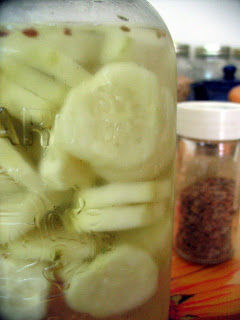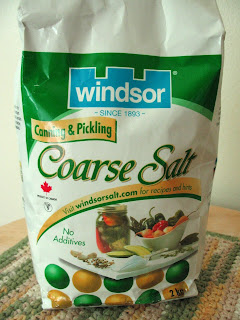The last few years I've done a wee bit of preserving each fall. I've tried something new every year. Despite the effort spent chopping, peeling or straining, and the time spent over the stove stirring and boiling jars, I inexplicably worked in small batches, yielding just a few jars of whatever it was I made. I wasn't overly confident at the start. The process seemed daunting. I certainly wasn't prepared to purchase a large canner for boiling jars which would take up a whole cupboard and sit unused the rest of the year. And I really didn't want to end up with 20 jars of something that didn't work out.
But, to my surprise, it wasn't that hard. It did take a fair bit of patience, but it was rewarding. Over the years I've tried: apple butter (after I discovered there is no butter in apple butter), concord blue grape jelly (when I discovered that these grapes are terrible for eating), and crab apple jelly (when a friend discovered that the pesky tree dumping little bits of fruit into her back yard actually produced something wonderful).
Last year I found a fantastic book at the library called "The Complete Book of Pickling: 250 Recipes from Pickles and Relishes to Chutneys and Salsas" by Jennifer MacKenzie. I suddenly felt really ambitious and tackled curried pickled cauliflower, dill pickles, corn and tomato salsa and peach chutney. And I moved on to slightly bigger batches, so I still have a jar of each of the last two.
I also still have an enormous bag of pickling salt...
If you're trying pickling for the first time, I suggest you buy only as much as you need at a bulk store. Pickling salt (left) is much coarser than table salt.
Last year's dill pickles were surprisingly good. I used one of the recipes for Classic Quick Dill Pickles* (slightly adapted) from the book and decided to make them again this year. *The book credits Pat Burley with the original recipe.
I bought a nice batch of baby dill cucumbers. And then a very long time passed. When I finally had time to make my pickles, I found some very sad looking cucumbers. Here's the worst one:
What to do? I really really hate throwing food away (unless it's harmful). But these cukes weren't dangerous, just ugly. So, I peeled off the wrinkly skins and they were still nice and crisp. I sliced them up and invented what I'm calling...
Quick Refrigerator Dill Pickles
Makes 2 - 1 litre mason jars
3 litre basket of baby dill cucumbers
3 1/2 cups of water
1 1/3 cups of white vinegar
1 1/2 tablespoons of pickling salt
1 tablespoon of granulated sugar
2 cloves of garlic, cut in half
2 tablespoons of dill seed
Equipment: 2 - 1 litre mason jars with lids (disks and bands)
Note: Because these jars go directly into the fridge, there is no need to process them in a water bath canner. However, if you want to make true preserves, it's essential that you follow your recipe's instructions and recommended times for processing the jars to ensure food safety. For this recipe, it is still essential to sterilize the jars and to use new disks and bands (or at least fairly new ones free of dents and rust) and it's helpful to read through the recipe before starting.
Start by boiling a large kettle of water for sterilizing.
If skins are wrinkly, peel cucumbers. Otherwise just scrub them and slice them into coins. In a medium pot combine sugar, salt, water and vinegar. Bring to a boil over medium heat and stir until sugar and salt are dissolved.
While mixture is heating, sterilize jars. To sterilize, place jars in a sanitized sink and pour boiling water over all parts, including lids.
Place one clove of garlic and one tablespoon of dill seeds in each jar.
Divide cucumber slices between the two jars. Pour in hot pickling liquid leaving about 1/2 inch (1 cm) of room at the top for air. Wipe the rim and place hot lid disc on jar. Screw on band and let jars cool. Even though you're not processing the jars, the jars will probably still seal - you will hear them pop. Whether or not this happens, once the jars cool, put them in the fridge.
Now here's the not so quick part. You'll still want to leave them for about a week before you try them. But it will be worth the wait. In the fridge, they should keep for about 2 months after opening.








No comments:
Post a Comment
Thanks for your feedback! - Prairie Lemon
Please note: Comments are moderated, so yours may not appear immediately. You could always try a recipe while you're waiting!